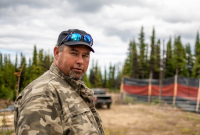Support strong Canadian climate journalism for 2025
This Sunday is World Wildlife Day, a day when the world celebrates the wild animals on our planet. A good day to reflect on the plight of billions of animals impacted by a key driver of biodiversity loss: the multibillion-dollar legal wildlife trade.
While it’s probably well-known that wildlife populations are declining rapidly, what might not be apparent is that our consumption patterns are in part responsible for the decline in species in Canada and elsewhere.
Every year, millions of native and non-native wild animals are captured or bred and traded in Canada for the pet industry, trinkets and other non-essential uses. The reality is that the trade in wild animals is mostly legal, underregulated and largely unmonitored.
It’s deeply concerning that little attention is given to this key driver of biodiversity decline by the media or by our political leaders. This is a significant problem.

Canada has the ambitious 2030 target to ensure that the wildlife trade is sustainable, legal and safe for people, animals and the environment. Time is running out for meaningful action and little progress has been made so far.
If anything, we should learn from First Nations, Inuit and Métis how to protect biodiversity. The reality is, 80 per cent of the most biodiverse regions remaining on the planet are inhabited by Indigenous people.
Additionally, we need to move away from only discussing the wildlife trade and its unsustainability through the lens of illegal trade. Instead, we need to have an honest conversation about the impacts of the legal wildlife trade. The legal trade is unsustainable, fuels the illegal trade and poses severe risks to public health through the spread and emergence of zoonotic diseases.
More resources and investments are needed to address the risks and challenges related to this issue.
Currently, we don’t really know which wild animals are being imported into our country, where they are coming from or what happens to them once they are here. Between 2014 and 2020, 84 per cent of animals imported into Canada lacked a proper species description.
Important research by the Monitor Conservation Research Society discovered there have been only five published research articles since 2010 about the wildlife trade in Canada. This is despite Canada being frequently mentioned as a key wildlife export or import country in global studies.
These findings beg the question: What are our wildlife trade policies based on if data doesn’t exist?
Additionally, despite being the second-largest country by landmass, Canada has less than 100 federal wildlife enforcement officers. In comparison, there are close to 1,200 places in Canada where wildlife can be brought in and out.
The lack of enforcement resources, paired with a siloed government approach where at least four federal ministries (environment, public safety, fisheries and oceans, and health) that are engaged on different, yet very specific parts of the wildlife trade are hindering effective management of the wildlife trade and its impacts.
This is the reason why World Animal Protection Canada is now calling on the federal government to move wildlife trade under a single reporting structure and ensure there’s adequate funding to address this crisis holistically.
We welcome Canada’s commitment to introduce a Nature Accountability Bill. However, the bill must acknowledge the legal wildlife trade as a key driver for biodiversity loss. Finally, Canada should develop clear and measurable indicators to meaningfully report progress on our 2030 biodiversity goals.
If Canada is serious about halting and reversing biodiversity loss — and meeting its international obligations — it cannot ignore its role in the growing legal commercial trade of native and non-native wild animals.
Michèle Hamers has written and contributed to numerous reports and papers on Canada’s role in the commercial wildlife trade, including regulatory solutions, the use of wild animals as pets and risks related to the import of wild animals into Canada. She has a BSc in animal husbandry from HAS University of Applied Science in the Netherlands and an MSc in animal biology and welfare from the University of Essex, U.K. Professional recognitions include European professional biologist (EurProBio), registered scientist (RSci) with the Royal Society of Biology and master herpetologist.






Comments